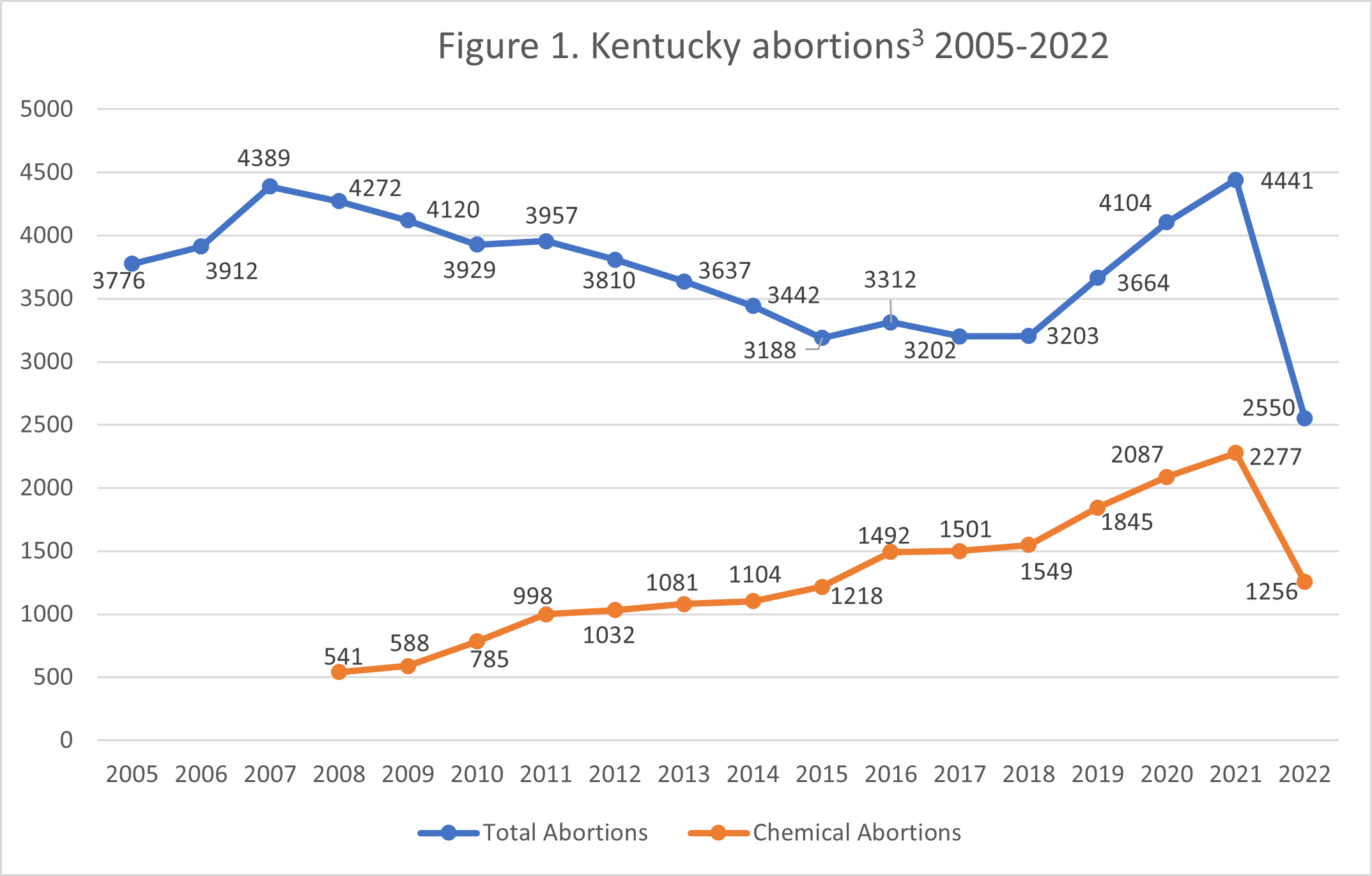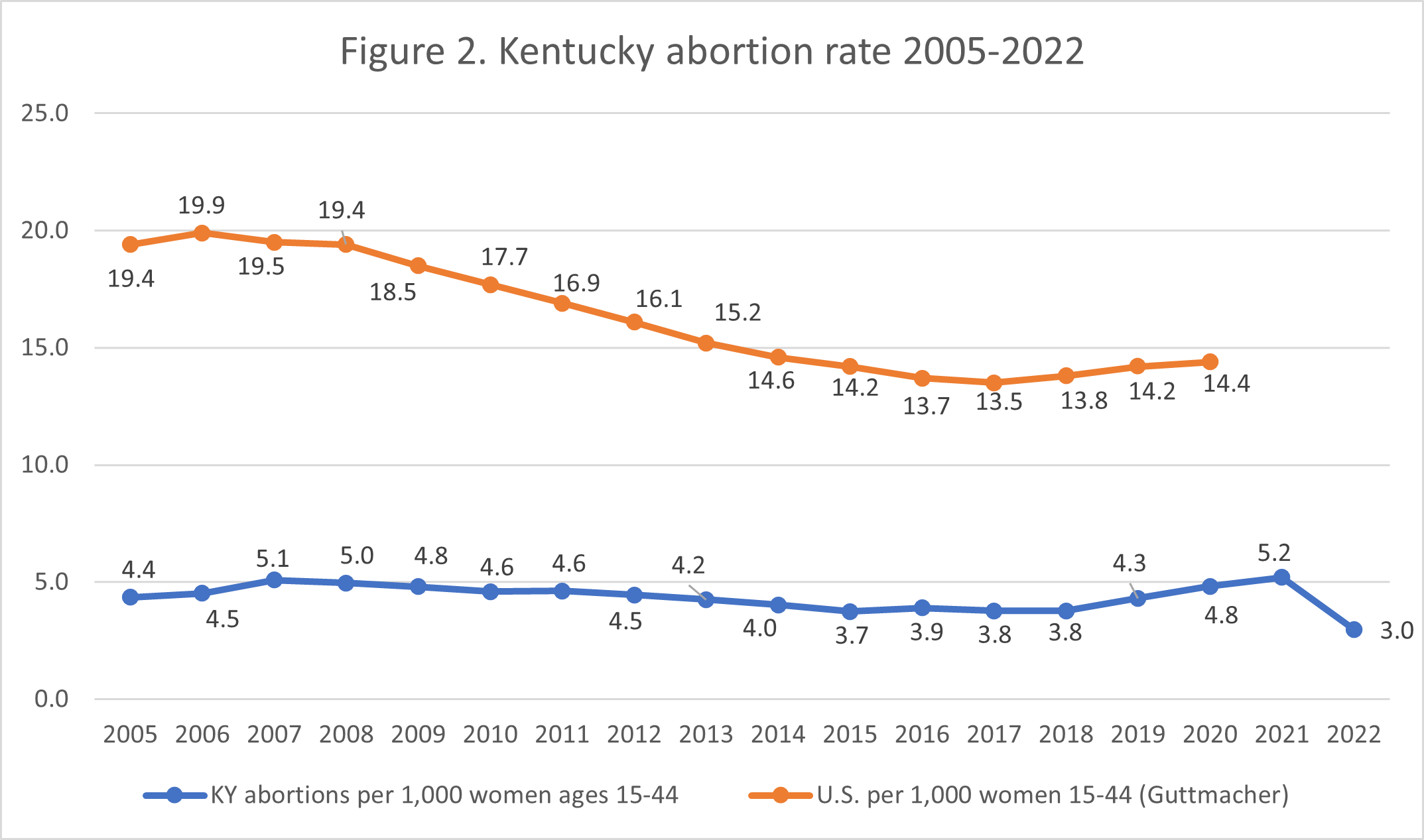Kentucky’s 2022 abortion report was published by the Kentucky Cabinet for Health and Family Services in October 2023.
Abortion Totals and Trends
There were 2,550 abortions reported in Kentucky in 2022, a 43% decrease from the previous year (Fig. 1). Chemical abortions also decreased significantly, by 45%, from 2,277 in 2021 to 1,256 in 2022. Chemical abortions composed just under half (49%) of the total in 2022. The Charlotte Lozier Institute (CLI) estimates that Kentucky’s abortion rate was 3.0 abortions per 1,000 women of childbearing age (Fig. 2).1 As of November2023, 23 states have released 2022 abortion statistics, of which 10 showed that abortions decreased from the previous year.
State Report Summary
In 2022, 84% of abortions reported in Kentucky were on state residents, and 16% were on residents of other states. The states with the greatest numbers of residents who obtained abortions in Kentucky were Indiana (8%), Tennessee (5%), and Ohio (2%).
Eight percent of Kentucky abortions were obtained by girls ages 19 and younger. Thirty-three percent were obtained by women ages 20 to 24, and 27% were performed on women ages 25 to 29. Thirty percent of the abortions were conducted on women in their thirties, while 3% were obtained by women ages 40 and older.
Just under half of the abortions (49%) were obtained by white women, while 37% were obtained by black women. Thirteen abortions (0.5%) were obtained by American Indian women, and 13% by women of other races. Race was not reported for 16 abortions. Eighty-nine percent of Kentucky abortions were on non-Hispanic women, and 11% were on Hispanic women. Ethnicity was not reported for one abortion. CLI estimates that Kentucky’s black abortion rate was 11.4 abortions per 1,000 women ages 15 to 44, nearly seven times the white abortion rate of 1.7 abortions per 1,000 women ages 15 to 44.
Follow LifeNews on the MeWe social media network for the latest pro-life news free from Facebook’s censorship!
Forty-eight percent of the abortions were obtained by women with only 12 years of education or fewer, while 41% were on women who had completed one to four years of college. Ten percent were performed on women who had finished five or more years of college, an increase from 2021 when 5%of Kentucky abortions were on women with five or more years of college completed. Eighty-eight percent of Kentucky abortions were performed on unmarried women, compared to 12% on married women.
Thirty-four percent of the abortions reported in Kentucky were obtained by women with no previous live births. Twenty-eight percent were on women with one prior live birth, and 39% were on women with two or more live births. Sixty-three percent were obtained by women who reported no previous abortions, 23% by women with one prior abortion, and 14% by women with more than one previous abortion. Twenty-two percent of Kentucky abortions were performed on women who had previously had a miscarriage.
Just under half the abortions reported in Kentucky in 2022 – 49% – were chemical abortions. Fifty-one percent of the abortions performed in Kentucky were surgical, with 46% performed via the suction curettage method, 5% via dilation and evacuation, and one abortion via hysterectomy/hysterotomy.
Five percent of Kentucky abortions were performed at five weeks of gestation or earlier, increasing to 25% at six weeks. Thirty-five percent of Kentucky abortions were performed between seven and eight weeks of gestation, and 16% were reported between nine and 10 weeks of gestation. Eight percent occurred between 11 and 12 weeks of gestation, 6% between 13 and 15 weeks, and 4% between 16 and 19 weeks. There were 14 abortions at 20 weeks and 11 abortions at 21 weeks of gestation.
During part of the time period this report covers, Kentucky limited abortion at 20 weeks post-fertilization (around 22 weeks of gestation) unless the mother’s life or a major bodily function was at risk. In 2022, there were zero abortions after 20 weeks post-fertilization. On June 24, 2022, Roe v. Wade was overturned and Kentucky’s heartbeat and life at conception laws both went into effect until June 30, 2022, when they were temporarily blocked. In the beginning of August 2022, both laws went back into effect and currently remain in effect.
Kentucky’s 2022 abortion report was the third to include information on complications from abortions performed in the state.2 More than one complication could be reported for each abortion. In 2022, 2,548 abortions did not result in reported complications, while two abortions were incomplete or complicated by retained tissue.
Abortions by Facility and Month
The overwhelming majority of Kentucky abortions, 83%, were performed at EMW Women’s Surgical Center in Louisville. Seventeen percent were performed by Planned Parenthood. Three abortions were performed at Norton Hospital, two at the University of Louisville, and one each at the Norton Women’s and Children’s Hospital and Chandler Medical Center.
March had the highest monthly abortion total (474 abortions), while zero abortions were reported for September, November, and December.
| # of Abortions | |
| January | 403 |
| February | 384 |
| March | 474 |
| April | 324 |
| May | 378 |
| June | 304 |
| July | 280 |
| August | 1 |
| September | 0 |
| October | 2 |
| November | 0 |
| December | 0 |
After Kentucky’s life at conception and heartbeat laws went into effect in early August, the number of abortions occurring in the state dropped to nearly zero.
State Ranking
In a 2016 CLI report evaluating abortion reporting across the country, Kentucky was ranked 43rd. Since then, Kentucky has made improvements to their abortion reporting requirements and now requires abortion providers to report complications. The state’s annual abortion reports are now made available to the public online. Kentucky could continue to make improvements by requiring all health care providers, including emergency room providers, to report abortion complications they treat. Furthermore, the state could require that abortion facilities provide women’s reasons for abortions, as some states do, and ensure that the grounds for any exceptions to the state’s pro-life laws are reported.


- National rates were calculated by the Guttmacher Institute. Kentucky rates were calculated by CLI using the following formula: (total number of abortions performed in Kentucky ÷ number of resident women ages 15-44 [based on most recent population estimates]) x 1,000. Rates may differ slightly from previous CLI articles due to revised population estimates. Population estimates were obtained from the CDC WONDER database. Estimates for 2005-2009 are intercensal estimates of the July 1 resident population. Estimates for 2010-2019 are Vintage 2020 postcensal estimates of the July 1 resident population. Estimates for 2020-2022 are Vintage 2022 postcensal estimates of the July 1 resident population. Estimates were produced by the U.S. Census Bureau and the National Center for Health Statistics.
- Statistics on abortion complications reported here represent a minimal number of deaths and complications, as this data is collected in a non-systematic and non-verifiable way. As such, this data cannot be used to calculate either an accurate abortion mortality rate or an accurate abortion complication rate for the state.
- Kentucky published reports for 2017 through 2022 online and provided CLI with reports for 2015 through 2018. Abortion totals for 2005 through 2014 were taken from the annual abortion surveillance reports published by CDC. Kentucky first reported chemical abortion data to CDC in 2008.
LifeNews Note: Mia Steupert serves as Research Associate at the Charlotte Lozier Institute, where she conducts and edits research on a variety of topics related to science and statistics for life. Tessa Longbons is a research associate with Susan B. Anthony List’s research arm, Charlotte Lozier Institute.








